
Features
Safety
A Safer Approach
For Mike Newransky, the mere thought of being branded a “hero” for the work he embraces makes him seriously ponder the meaning of the word.
July 6, 2011 By Stacy Bradshaw
For Mike Newransky, the mere thought of being branded a “hero” for the work he embraces makes him seriously ponder the meaning of the word.
As one of 46 fixed-wing pilots flying for Ontario’s not-for-profit transport medicine firm, Ornge, Newransky has spent the past two years traversing the vast expanse of northwestern Ontario, flying out of Ornge’s Transport Medicine Centre of Excellence in Thunder Bay. He has flown countless missions with first officer Jeff Brendish and various two-person paramedic teams into tiny airstrips in places most have never heard of. The team provides residents with the most precious of commodities – critical medical attention when they’re in their most vulnerable state.
From helping the severely injured following serious car crashes on Ontario’s most northerly roads, to dealing with critical care cases in remote parks, to patient transfers between medical facilities, it’s all part of the Ornge mandate. And it’s a responsibility every member of the more than 400 Ornge employees across the province holds in the highest regard. “It’s absolutely satisfying to know what you are doing for a patient, but the hero term I really don’t like to use,” says Newransky. “I think of myself more as a servant.”
And while Newransky feels proud when asked about the impact he’s had as an Ornge pilot, it’s his experience as a patient’s loved one that humbles him the most – and makes him seriously evaluate the hero moniker.
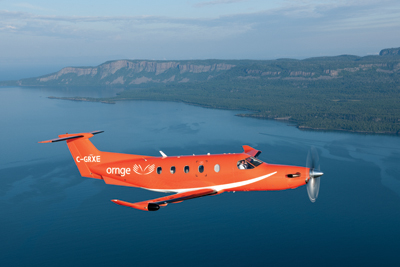 |
| The Ornge fleet of Pilatus PC-12NG aircraft takes part in more than 21,000 patient transports annually. Photo: Ornge. Advertisement
|
In April 2005, Newransky’s wife, Carla, suffered a heart attack while at work in Thunder Bay. He was off duty at the time and got the call from his Ornge co-workers with the tragic news. In shock, he donned the patient’s escort chair behind his usual captain’s chair while co-workers attended to Carla. They were airlifted to Sudbury by one of the Ornge subcontractors, Thunder Airlines. Fortunately, they made it to the hospital in time, and Carla has since recovered, but the experience gave Newransky a unique perspective on his role as an Ornge employee and a better understanding of what he does as a pilot.
“Suddenly, here I was the spouse of a patient,” he says. “As a pilot, I had flown regularly with this team, I was with medics I had worked with on a regular basis, so, it really hit home for them. I could tell it was more than just a job . . . it was more than just building time.
“There are a lot of people at Ornge who look at it like it’s more than just flying, which is why you have that level of compassion to the buzzwords that they use. Because, at the end of the day, we can say that we were instrumental in saving someone’s life. And there is a good feeling about that. But you are serving; it’s not so much about the hero complex – I use that word very, very carefully.”
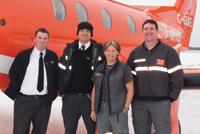 |
|
| Members of the Ornge Timmins crew before their flight. From left: Chad Barnhart (pilot), Devon Michaels (pilot), Tina Lennon (paramedic) and Dan Lefebvre (paramedic). Photo: Matt Nicholls |
An Ornge awakening
A vital part of Ontario’s medical system, Ornge provides sophisticated medical transport for ill and critically injured patients in the air and on the ground. The history of the non-profit organization dates back to 1977 when the province established a helicopter-based aero-medical program at Toronto’s Buttonville Municipal Airport associated with Sunnybrook Hospital.
After more than two decades of service, the program grew to include a variety of aircraft and several bases across Ontario. In 2002, base hospitals in Sioux Lookout, Thunder Bay, Sudbury, Timmins and Toronto were amalgamated under the Ontario Air Ambulance Base Hospital Program.
In 2005, the Ontario government announced the OAASC (Ontario Air Ambulance Services Co.) was appointed to co-ordinate all aspects of the province’s air ambulance services. The company changed its name to Ornge in 2006, a play on words to describe the uniqueness of the colour of the medical transport vehicles. Since assuming responsibility for all aspects of the provincial transport medicine programs in 2006, Ornge has been actively seeking ways to modernize its service and make it more sustainable for years
to come.
Serving an area of more than 1.1 million square kilometres is a daunting task, especially given the province’s unique geographical and climate-related realities. To ensure the safe transport of patients to and from medical facilities provincewide, Ornge deploys a variety of fixed- and rotary-wing aircraft from its various bases.
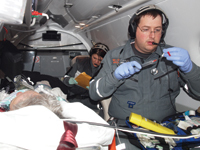
|
|
| Paramedics Mike Rumble (foreground) and Anik Malabossa care for a patient in-flight aboard the PC-12NG. Photo: Matt Nicholls |
The Ornge air fleet includes 11 Sikorsky S-76 helicopters, an aging fleet that is currently being phased out after the introduction last year of 10 state-of-the-art AW-139s from AgustaWestland. Ornge also owns 10 Pilatus PC-12 fixed-wing aircraft and has access, through its subcontracting agreements, to more than 50 aircraft operating a number of bases across Ontario. The co-ordination of these medical assets is a challenging task, as helicopters, fixed-wing aircraft and critical care land vehicles handle approximately 21,000 transports annually.
Co-ordination of all medical transport assets is handled from the company’s head office and medical command centre in Mississauga, an impressive facility that houses administrative offices, the Ornge Academy of Transport Medicine, and a busy control centre, known as the Ornge Communications Centre, manned by a bevy of communications officers at the ready to cycle priority calls to various bases for crew deployment. It’s a highly complex operation, which accurately reflects the Ornge mandate – compassion, collaboration and innovation to provide the highest level of care to patients in need quickly and efficiently.
Ornge CEO Christopher Mazza has witnessed firsthand the tremendous disconnect that can exist between the medical and air transport teams, and it’s a situation he contends will never happen at Ornge. “Transport medicine is not about aviation and medicine. It’s not about ‘you fly and we’ll do our thing.’ It’s a team,” says Mazza, an emergentologist who has had an accomplished career as a transport medical professional in the U.S. and Canada. “It’s the integration of the two most regulated professions on the planet in a marital relationship. You don’t make decisions without me. I don’t make decisions without you. Ornge was created on that philosophy.”
| The Pilatus story
Fast facts about the Pilatus PC-12NG The multi-purpose Pilatus PC-12NG is a single-engine turboprop passenger and cargo aircraft. Introduced in 1989 at the National Business Aviation Association show by Stans, Switzerland-based Pilatus Aircraft, its primary users are civilian and government operators, including Canadian organizations such as Nakina Air Service, Express Air, Pascan Aviation, Air Bravo, Ornge, OPP, RCMP, and the Nishnawbe-Aski Police Service. Key features:
|
Excellence personified
The Ornge philosophy is easily discernable at the Transport Medicine Centre of Excellence in Thunder Bay. Located on the south side of Thunder Bay International Airport, it’s a miniature version of the main headquarters in southern Ontario – a state-of-the art medical training facility housing everything the main northern base needs from administrative support to medical simulator training rooms.
When not on call, there’s also ample opportunity for pilots and medics to relax in quiet areas, a gym, and other luxuries they so rightfully deserve given their challenging roles. The Thunder Bay base also has a full-service hangar and is adjacent to aircraft supplier Pilatus Centre Canada, which does all the maintenance on the fleet’s PC-12NG (see “Helping hands,” pg. 36).
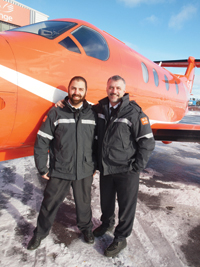 |
|
| Ornge PC-12NG pilots Jeff Brendish and Mike Newransky contend they are not heroes: “We are serving the public. I use the term hero very carefully,” says Newransky. Photo: Matt Nicholls |
Some 24 Ornge pilots call Thunder Bay home (the two other fixed-wing bases in Sioux Lookout and Timmins also have 11) and, as chief pilot Jim Bennett notes, the team brings just the right mix of experience, attitude and commitment to the table. Skills he looks for when seeking new staff include glass cockpit experience, dealing with varied weather conditions and adaptation to rapidly changing situations. Compassion, innovative thinking and a team-oriented perspective are also important.
“I’d hate to hang my hat on the fact that they are from the north, but it’s a very dynamic, interesting place to work,” says Bennett. “You’re taking people into a somewhat stressful position. We know nothing about the condition of the patient, but a lot of our calls are critical, so having people who are from the area or are somewhat familiar with the area and the environment is great.
“Innovative thinking is nice, too. Sometimes, we are told the runway is clear in a northern reserve and it’s clear, but it may have snowed the night before and now it’s not clear. So, that’s where the innovation comes in. Our pilots have some of the best equipment at our bases, but if it’s not safe, we don’t go. Safety is paramount and we simply don’t take chances.”
Bennett says he’s always impressed with the commitment of the Ornge team in dealing with the myriad situations that can occur in a given shift. Pilots and medics have to be ready at the drop of a hat to be deployed to any number of locations throughout the province – calls often change while they’re in flight – and to deal with different medical emergencies, or the possibility of a “duty out” situation in a remote destination.
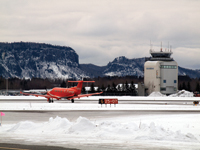 |
|
| “I feel as at home landing the PC-12NG in remote areas as I do at bigger airports,” says pilot Mike Newransky. Here, the Timmins crew taxis at Thunder Bay International Airport. Photo: Matt Nicholls |
During a rideout from the Thunder Bay base in January, the crew I flew out with – Newransky, Brendish, paramedics Mike Rumble and Anik Malabossa – dutied out in Sudbury after we had successfully transported a 60-year-old cardiac patient from Kirkland Lake to a waiting ambulance for transport to Sudbury Regional Hospital. At 10:30 p.m., it was too late to safely return to the base in Thunder Bay so the crew stayed at a local hotel. Newransky, Brendish and I returned in the PC-12NG the next morning.
“This is what it’s like as a member of the Ornge team,” said Rumble over a bowl of steaming oatmeal the next morning. “We’re constantly on the go and the due to the nature of the job, you just have to stay flexible.” Added Brendish: “We just don’t compromise on safety; you fly when it’s safe. Everything we do is based on this premise.”
Bringing it all home
The secure transportation of patients throughout the province is made possible not only by Ornge staff but by the aircraft it flies. The PC-12NG is a highly respected aircraft that gets outstanding praise from both medics and pilots for its versatility and configuration as a flying hospital. Medically configured in Thunder Bay by Pilatus Centre Canada, the aircraft has the right mix of power and reliability to get crew to patients, and get them safely on their way.
“I simply love it,” says Bennett. “I came off a Challenger 604 and I came on to this, and I have to admit, it is simply a phenomenal aircraft to fly . . . and the avionics are amazing. It’s the ideal aircraft for what we do.”
Newransky concurs, adding that the strength of the aircraft is reflected in the organizations entrusting it to their own operations, including the Ontario Provincial Police, Royal Canadian Mounted Police and Royal Flying Doctor Service in Australia.
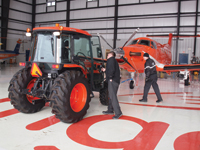 |
|
| AMEs and members of the Ornge Timmins crew prepare the PC-12NG Pilatus for a mission flying out of Thunder Bay International Airport. Photo: Matt Nicholls. |
“The nice thing about the PC-12NG is it has already been used for medevac operations in the past, so Ornge is flying a proven model,” he says. “And they run like a Swiss watch. They are extremely versatile aircraft with an ergonomically friendly cockpit. For the mechanic turning the wrench, everything is properly laid out – they love working on the aircraft.”
Bennett agrees and says the right choice of aircraft is just an extension of Ornge’s commitment to serve Ontarians with the best medical transport possible. It’s a role that even this veteran aviator of 30-plus years gets choked up over, which he did when describing his team.
“It’s not just a sense of accomplishment when you move a critically ill person; it’s a feeling of being human,” says Bennett. “It’s hard to describe, but at the end of the day I look at it like this: I have excellent people working for me, they do an excellent job, and I sleep better at night.”
And thanks to Ornge, thousands of Ontario residents will sleep better at night as well.
| Helping hands
Maintaining the PC-12NGs for Ornge is a significant challenge, one the team at Thunder Bay’s Pilatus Centre Canada Ltd. is ready and willing to take on The Pilatus Centre Canada team currently has a maintenance contract with Ornge and is in the process of finishing up the retrofitting of the interior for the last of 10 PC-12NGs for Ontario’s not-for-profit medical air transport provider. Delivery of the last aircraft is expected later this summer. Pilatus Centre Canada equips the planes with medical equipment and cabinets from Washington-based LifePort Inc. as well as avionics and communications systems necessary for effective flight. Conveniently located in a new state-of-the art facility right next to Ornge’s Transport Centre of Excellence, Pilatus Centre Canada is the Canadian distributor of Pilatus PC-12 aircraft. Part of the Kelnar Group, the company was founded in 1997 by prominent northwestern Ontario aviation mogul Frank Kelnar. “Part of the reason for the development of the next facility was to increase our own capacity,” says vice-president Steve Davey. “We have 11,000 square feet in the new hangar and it houses all of our administration and shop space. The new facility will also include the maintenance, parts, sales and finance departments. Everyone is under one roof.” The new operations will help the Pilatus Centre Canada continue to be a leading service provider for Pilatus aircraft countrywide. |